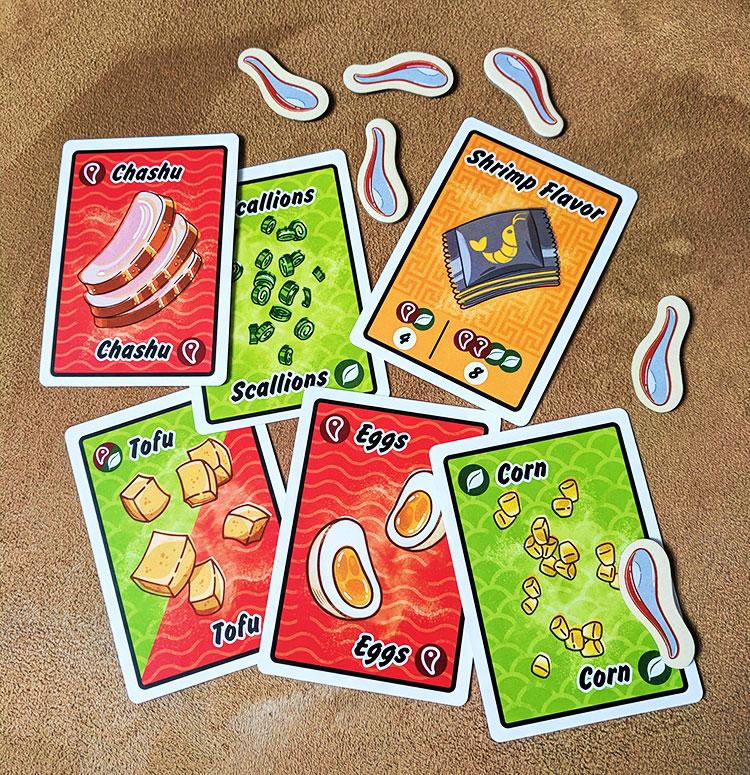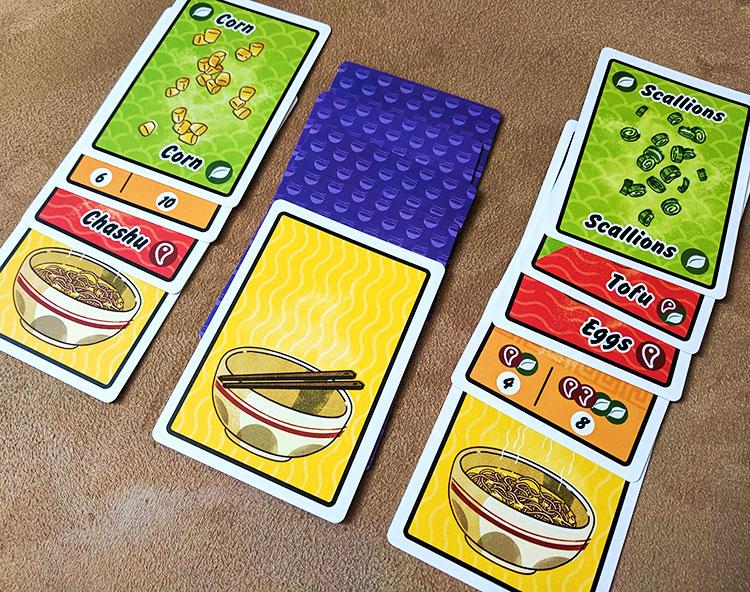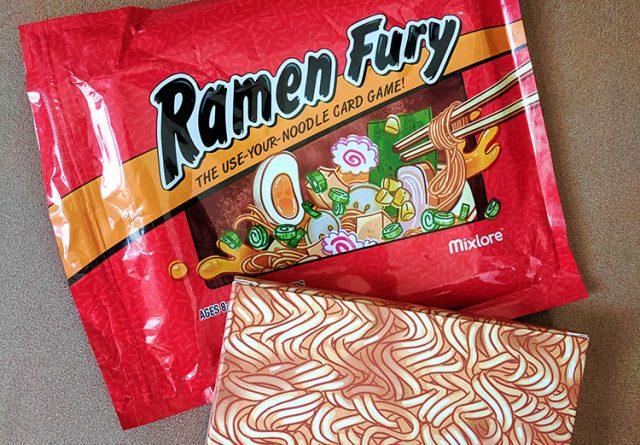Introduction:
I played Ramen Fury, created by Forrest-Pruzan Creative, Prospero Hall, and Chris Rowlands for audiences aged 8+. Played in person, Ramen Fury appeals to families and younger audiences, but also to anyone who enjoys food themes and light-hearted gameplay.
Players begin with three empty ramen bowls and on each turn, perform two actions: drawing ingredients, placing them, clearing the current ingredients, or “’eating” a bowl to score points. The gameplay of Ramen Fury revolves around drawing and playing ingredient cards like eggs, mushrooms, chashu, etc. to maximize points based on specific ramen recipes.

The bowls are scored according to their ramen flavor, which includes a recipe that outlines what kind of ingredients are needed for the bowl, as well as how many points can be gained from eating it. The bowls cannot be eaten without flavor in them, which makes the game more competitive since players can steal flavors they believe other players are going for.
Analysis:
An interesting mechanic in Ramen Fury is the inclusion of chili peppers and nori garnish, which are the only ingredients that players can place on other people’s bowls.The chili peppers subtract points from the bowl, so players can use this to sabotage others. This creates interesting dynamics as players may ally to put multiple chili peppers on players that are ahead to completely ruin their bowl. However, there is a built-in balancing mechanic with the “fury flavor” that scores chili peppers for points. Thus, players sometimes act as if they’re disappointed by getting peppers, and then they place a fury flavor to make a comeback. Other times, some players make alliances to not put chili peppers on each other, and there are last minute betrayals as people try to eat their bowls before the game ends.
Another key mechanic in Ramen Fury is that the ingredients in the ramen bowls form a “stack.” This means that if a player places an ingredient on top of another in the stack, all the ingredients under it are safe from being disrupted by other players. This allows players to possibly secure key components of their ramen bowls, like tofu that count for multiple different recipes, from being stolen or spoiled by competitors.

The rules outline that the game ends after the last bowl is eaten, which means that players must carefully time their actions. Maintaining pace with others becomes very crucial, as players can craft a high-value bowl, but it’s worthless if not eaten before the game concludes. The rules also don’t allow partially emptying ramen bowls, so when they become filled, the player can only throw out all the ingredients or choose to eat it. Because of this rule, there is a competitive dynamic where players try to fill up high value bowls with peppers or nori garnish before the player gets a chance to eat them, decreasing their points since they can’t fulfill their flavor recipe fully.
In Ramen Fury, the designers do a great job of creating competition that is consistent with the overall theme of eating ramen. The narrative of stealing each other’s ingredients for a better tasting bowl of ramen or making others taste worse is humorous and aligns well with the theme. Compared to other food-themed games such as Sushi Go!, Ramen Fury does a great job of having more direct interaction and competition. For example, In Sushi Go!, the interaction is more about predicting what the other players will do and less about direct confrontation like moving each other’s cards. There’s a passive interaction where players indirectly affect others by picking cards that others might need. On the other hand, Ramen Fury creates fellowship by encouraging more direct interaction through allowing players to actively disrupt each other’s dishes, creating a more competitive atmosphere.
Visually, Ramen Fury draws on sense pleasure as it captures the essence of a ramen shop with vibrant ingredient illustrations and thematic elements like “eating” your bowls of ramen. The design contributes to the desire to play the game. The game also engages players through challenge, as people are trying to optimize their ramen bowl, and also involves competition since everyone is trying to score as many points as possible with their ramen, and have the option to mess up other players. This competition can lead to intense moments, as players vie to sabotage each other’s dishes while improving their own, creating a dynamic atmosphere that can be both fun and fiercely competitive.
However, the gameplay can be very slow as players can only do two actions each turn. While this limit makes strategic planning very important, it also feels very restrictive and unsatisfying when trying to build the best ramen bowl. For example, during our play session it began to feel tedious watching people do the same thing over again and again. Everyone wanted to play nice and didn’t try to outright sabotage, but this limited the enjoyment of the game. Because of this, I feel that it heavily depends on the group of people playing to make the game fun by sabotaging others and creating chaos, which is not ideal since a great game should be enjoyable with any group. It may be better to have a different action mechanic that allows for more fast-paced and unpredictable gameplay that connects with the “Fury” theming. Some more elements of randomness to force players to create chaos would make the repetitive tasks of drawing ingredients and building the ramen bowls more interesting.
Our Take:
In our game, we hope to avoid problems with slow pacing that hurt Ramen Fury’s repeat playability and build in opportunities for chaos that make the game more interesting regardless of player style. For example, we will integrate randomness by introducing Event Cards into the game. These cards could be drawn at the start of each round and have various effects that change the game’s conditions for that round, like causing all players to swap one ingredient with the player to their right, or doubling the point value of meat ingredients temporarily. Our thought process is that the introduction of these cards creates moments of surprise and excitement that will make each play session unique and prevent repetitiveness. Ideally, this will also encourage players to think on their feet and constantly re-evaluate their strategies, leading to a more engaging and less predictable game experience.
To further combat the issue of slow gameplay, we plan to increase the potential actions and objectives within the game. Moving beyond the three-bowl limit of “Ramen Fury,” we will introduce a new element where players can serve their food to a variety of customers. Each customer will have specific recipe preferences and players will need to adapt their strategies based on which customers are currently available to serve. This will also open new opportunities for interaction among players. For instance, if a player notices that another is about to fulfill a high value customer order, they might decide to sabotage this effort by serving them before they get to it. This approach not only speeds up the game by allowing more frequent and varied actions but also adds a layer of depth as players have to manage multiple goals and adapt to the actions of other players.



